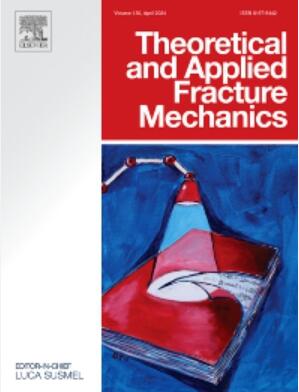花岗岩在不同热处理条件下的断裂机制:对冷却诱发破坏特征的洞察
IF 5
2区 工程技术
Q1 ENGINEERING, MECHANICAL
引用次数: 0
摘要
地热能开采和非常规油气开采不可避免地会对高温岩体产生冷却冲击。本研究研究了花岗岩在不同温度(20 ~ 400℃)和冷却方式(风冷和水冷)下的I型断裂特征和破坏机制。热处理的半圆弯曲试样进行三点弯曲试验。提出了SCB试件弹性模量的计算公式。系统地采用了先进的表征技术,包括断裂过程区(FPZ)和裂纹尖端张开位移(CTOD)测量的数字图像相关、断口形貌分析的三维激光扫描和断口微观结构检测的扫描电镜。为研究花岗岩热处理过程中温度和应力的变化,建立了三维非均质数值模型。综合实验和数值结果揭示了冷却方式对花岗岩断裂机制的影响。随着加热温度的升高,断裂韧性、应变能和能量释放率降低,而弹性模量先增大后减小。与风冷相比,水冷对花岗岩力学性能的影响更为显著。在峰值负荷阶段,FPZ长度和临界CTOD随加热温度的升高而增加,在400℃时显著增加。但FPZ宽度变化不明显。水冷花岗岩始终表现出比风冷花岗岩更长的fpz和更高的临界ctod。随着温度的升高,表面粗糙度系数增大,但弯曲度先增大后减小。结果表明,水冷却导致裂缝路径更加曲折,裂缝表面更加粗糙,裂缝渗透率降低。研究结果可为提高深层能源开采效率提供理论和工程指导。本文章由计算机程序翻译,如有差异,请以英文原文为准。
Fracture mechanisms of granite subjected to varied thermal treatments: Insights into cooling-induced failure characteristics
Geothermal energy extraction and unconventional oil and gas production inevitably result in cooling shocks for high-temperature rock masses. In this study, the mode I fracture characteristics and failure mechanisms of granite under different temperatures (20–400° C) and cooling methods (air cooling and water cooling) were investigated. Heat-treated semi-circular bend specimens were subjected to three-point bending tests. A formula for calculating the elastic modulus of SCB specimens was proposed. Advanced characterization techniques, including digital image correlation for fracture process zone (FPZ) and crack tip opening displacement (CTOD) measurement, 3D laser scanning for fracture surface morphology analysis, and scanning electron microscopy for fracture surface microstructure examination, were systematically employed. A 3D heterogeneous numerical model was established to study granite temperature and stress changes during heat treatment. The integrated experimental and numerical results reveal the influence of cooling methods on granite fracture mechanisms. As the heating temperature rose, fracture toughness, strain energy, and energy-release rate decreased, whereas the elastic modulus first grew and then decreased. Compared with air cooling, water cooling caused more significant deterioration to the mechanical properties of granite. At the peak load stage, both FPZ length and critical CTOD grew with heating temperature, with a notable increase at 400 °C. However, the FPZ width did not change significantly. Water-cooled granite consistently exhibited longer FPZs and higher critical CTODs than air-cooled granite. With increasing temperature, the surface roughness coefficient increased, but the tortuosity first increased, then decreased. It was found that water cooling resulted in more tortuous fracture paths and rougher fracture surfaces, as well as lower fracture permeability. These findings can provide theoretical and engineering guidance for enhancing deep energy extraction efficiency.
求助全文
通过发布文献求助,成功后即可免费获取论文全文。
去求助
来源期刊

Theoretical and Applied Fracture Mechanics
工程技术-工程:机械
CiteScore
8.40
自引率
18.90%
发文量
435
审稿时长
37 days
期刊介绍:
Theoretical and Applied Fracture Mechanics'' aims & scopes have been re-designed to cover both the theoretical, applied, and numerical aspects associated with those cracking related phenomena taking place, at a micro-, meso-, and macroscopic level, in materials/components/structures of any kind.
The journal aims to cover the cracking/mechanical behaviour of materials/components/structures in those situations involving both time-independent and time-dependent system of external forces/moments (such as, for instance, quasi-static, impulsive, impact, blasting, creep, contact, and fatigue loading). Since, under the above circumstances, the mechanical behaviour of cracked materials/components/structures is also affected by the environmental conditions, the journal would consider also those theoretical/experimental research works investigating the effect of external variables such as, for instance, the effect of corrosive environments as well as of high/low-temperature.
 求助内容:
求助内容: 应助结果提醒方式:
应助结果提醒方式:


